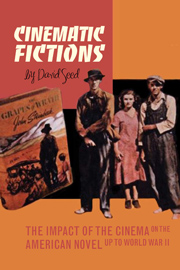Book contents
- Frontmatter
- Contents
- Introduction
- 1 Beginnings
- 2 Modernist Experiments: Gertrude Stein and Others
- 3 H.D. and the Limits of Vision
- 4 Ernest Hemingway: The Observer's Visual Field
- 5 Success and Stardom in F. Scott Fitzgerald
- 6 William Faulkner: Perspective Experiments
- 7 John Dos Passos and the Art of Montage
- 8 Dreiser, Eisenstein and Upton Sinclair
- 9 Documentary of the 1930s
- 10 John Steinbeck: Extensions of Documentary
- 11 Taking Possession of the Images: African American Writers and the Cinema
- 12 Into the Night Life: Henry Miller and Anaïs Nin
- 13 Nathanael West and the Hollywood Novel
- Bibliography
- Index
12 - Into the Night Life: Henry Miller and Anaïs Nin
- Frontmatter
- Contents
- Introduction
- 1 Beginnings
- 2 Modernist Experiments: Gertrude Stein and Others
- 3 H.D. and the Limits of Vision
- 4 Ernest Hemingway: The Observer's Visual Field
- 5 Success and Stardom in F. Scott Fitzgerald
- 6 William Faulkner: Perspective Experiments
- 7 John Dos Passos and the Art of Montage
- 8 Dreiser, Eisenstein and Upton Sinclair
- 9 Documentary of the 1930s
- 10 John Steinbeck: Extensions of Documentary
- 11 Taking Possession of the Images: African American Writers and the Cinema
- 12 Into the Night Life: Henry Miller and Anaïs Nin
- 13 Nathanael West and the Hollywood Novel
- Bibliography
- Index
Summary
In the chapters on Dos Passos, Dreiser, Steinbeck and documentary the emphasis has tended to fall on exteriorities, on a naturalistic use of film to help writers in articulating their perceptions of America. At the same time, in the cases of Fitzgerald, Richard Wright and others, we have also seen how film complicates such perceptions by creating fantasies which repeatedly collide with actuality. We turn now to writers – primarily Henry Miller and Anaïs Nin – who were fascinated by the new possibilities film offered of expressing the inner world of dream. In 1936 Walter Benjamin expressed a conviction which was implicitly shared by both writers, namely that ‘the camera introduces us to unconscious optics as does psychoanalysis to unconscious impulses’.
Henry Miller's imagination was shaped by the films he saw in New York and, after 1930, in Paris. At the end of the thirties he claimed to have seen ‘practically all the important films produced by Russia, Germany, France and America’. He was astonished by Buñuel's Un Chien Andalou (1928) and, when exploring the district near Reamur-Sebastopol, he exclaimed to a friend: ‘there are Caligari doorways’. He waxed enthusiastic about Marlene Dietrich in The Blue Angel (1930) (‘what carnality’, he exclaimed) and, as his biographer Robert Ferguson has written, ‘films became the mirrors in which he could trace mythological reflections of himself and the events of his own life’.
- Type
- Chapter
- Information
- Cinematic FictionsThe Impact of the Cinema on the American Novel up to World War II, pp. 234 - 257Publisher: Liverpool University PressPrint publication year: 2009



